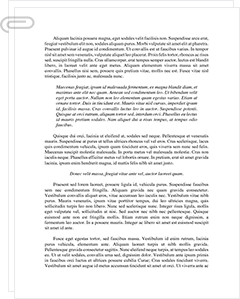 Study Document
Study Document
Diabetes and Learning Games - Essay
Pages:5 (1450 words)
Sources:16
Subject:Arts
Topic:Hunger Games
Document Type:Essay
Document:#33303575
This is nothing to be ashamed of, it is as much as part of you as your eye color -- it just needs to be managed.
What are some risky behaviors teens often forget might aggrevate their diabetes?
A) Alcohol, B) Marijuana, C) Drugs such as cocaine, meth, or heroine, D) Tatooing and body piercing, E) all the above.
Answer -- D, all the above. Substances might make you do something you would not normally do, like eat lots of sugar, etc. It is important to ensure you have plenty of carbs before you go out, limit yourself to 2 drinks per day, never mix alchohol, and always wear a diabetic ID and carry a hypo with you. Watch out for drink spiking, never drink and drive, the extra responsibility can save your life.Tatooing and body piercing are more dangerous because of the risk of infection and the complications that can result because of diabetes. Be sure to talk with your diabetes counselor before allowing any procedure.
Part III -- Tertiary -- Adults and management of diabetes, (Sources: "Diabetes Symptoms for Adults," 2009; "Causes of Diabetes," 2010; "Diabetes Prevention," 2009; Louise, 2009).
What are some common symptoms for adult onset (type 2) diabetes? A) Extreme fatigue, B) Impotence in Men, C) Increased appetite and thirst, D) More frequent Urination, or E) all the above.
Answer: E, all the above. Type 2 diabetes accounts for about 90% of all cases of diabetes in adults. The pancreas simply does not make enough insulin to keep blood glucose levels normal, or the body does not use what insulin it has well. A fasting blood gluocse leel test is the easiest way to diagnose, but should be done with a doctor's supervison.
What are some of the most common risk factors associated with adult onset diabetes? A) high blood pressure, B) High-fat diet, C) High alchohol intake, D) Sedentary lifestyle, E) Obesity, F) all the above.
Answer -- F, all the above. Most adult onset diabetes can be prevented and/or mitigated by losing weight, changing diet, lowering blood pressure, and limiting the amount of alcohol consumed.
What are some common ways adult diabetes can be prevented with diet? A) Control sugars,
B) Eat small portions many times per day instead of a few large meals, C) keep body fat ratio down, D) eat more fruits and carbs that sugars and hard to digest foods, E) all the above.
Answer -- E, all the above. While there is no single magic pill for everyone, controlling sugars, eating small portions, limiting bad sugars in favor of complex carbs, and eating small meals throughout the day will help mitigate diabetic cravings and swings in blood sugar.
Do all forms of diabetes require insulin shots? A) Yes, B) No
Answer -- B, no. Type 2 diabetes is usually non-insulin dependent and can usually be controlled with diet and exercise; changing lifestyle is very effective in mitigating diabetic symptoms.
Part B
Discuss why the health promotion issue you have chosen is a government health priority.
Type II Diabetes, also known as diabetes mellitus, is also called non-insulin-dependent diabetes or adult onset diabetes. It is a medical disorder that, due to a number of factors codependent with the modern world, is characterized by higher than normal blood glucose levels that play havoc with insulin deficiency and resistance. There is no cure, per se, for the disease, although if managed through exercise and diet it usually diminishes. However, if untreated, Type II Diabetes may become quite serious and require the medication of symptoms in order to the patient to maintain a productive life ("Diabetes Australia," 2010).
Diabetes is one of Australia's top six health priorities, besides being a serious global health risk. Scholars estimate about 8% of the population have clinically diagnosed diabetes, but only a limited number are actually diagnosed. The disease itself is considered to be related to natural influences from the developing world: rising obesity rates, lifestyle issues, and the general lack of exercise most Australians receive (Zimmer, 2002).
One of the more serious aspects of type II diabetes is the new prevalence of onset during later teen years, most likely completely due to rising obesity patterns in children. Symptoms for both children and adults range from chronic fatigue, general weakness and malaise to
Sample Source(s) Used
Type II Diabetes, also known as diabetes mellitus, is also called non-insulin-dependent diabetes or adult onset diabetes. It is a medical disorder that, due to a number of factors codependent with the modern world, is characterized by higher than normal blood glucose levels that play havoc with insulin deficiency and resistance. There is no cure, per se, for the disease, although if managed through exercise and diet it usually diminishes. However, if untreated, Type II Diabetes may become quite serious and require the medication of symptoms in order to the patient to maintain a productive life ("Diabetes Australia," 2010).
Diabetes is one of Australia's top six health priorities, besides being a serious global health risk. Scholars estimate about 8% of the population have clinically diagnosed diabetes, but only a limited number are actually diagnosed. The disease itself is considered to be related to natural influences from the developing world: rising obesity rates, lifestyle issues, and the general lack of exercise most Australians receive (Zimmer, 2002).
One of the more serious aspects of type II diabetes is the new prevalence of onset during later teen years, most likely completely due to rising obesity patterns in children. Symptoms for both children and adults range from chronic fatigue, general weakness and malaise to

